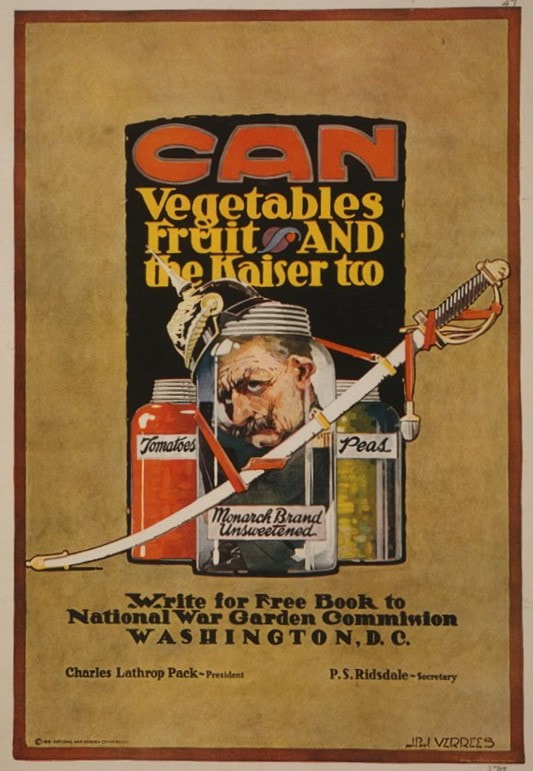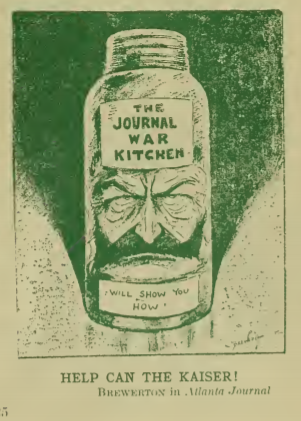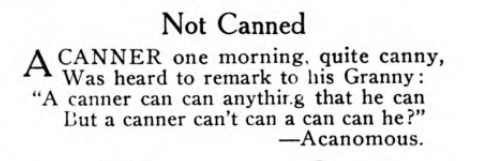|
"Can Vegetables, Fruit, and the Kaiser, Too. Write for Free Book to National War Garden Commission, Washington, D.C." September is still preserving time, so I thought the next few World War Wednesdays would be about canning. This is another of my favorite World War I propaganda posters. Developed by the National War Garden Commission, the poster shows glass jars with zinc tops. Tomatoes at left, peas at right, and front and center, the profile of Kaiser Wilhelm II, German Emperor and King of Prussia. His spiky German helmet and saber hang on the jar, which is labeled "Monarch Brand, Unsweetened." Eminently clever, the poster implies that home preserving has the power to defeat the might of the German Empire and the Kaiser himself. The First World War was one of the first times that ordinary Americans were called upon to preserve food in their homes. Many Americans, especially those in rural areas, were already canning and preserving the bounties of their home gardens. But as commercial canning became increasingly widespread, inexpensive, and safer, people with easy access to food retailers found it much easier to simply purchase canned goods, instead of going through the bother of putting up their own. Many people were still using the tried-and-true, but not necessarily safe, methods of their forebears. And while water bath canning was increasingly outpacing the traditional food preservation methods of fermentation, drying, and sealing jam with paraffin wax, water bath canning low acid vegetables still was not 100% safe. But as the government encouraged food conservation and food preservation, the National War Garden Commission stepped up to the plate. Founded (and funded) by timber magnate Charles Lathrop Pack, the National War Garden Commission published a series of food preservation pamphlets that were used all over the country by home economists and women's groups to encourage home canning. The National War Garden Commission was also behind the school garden movement, but that's another post. The Commission would go on to produce a number of pamphlets on war gardening (renamed "Victory Gardening" post-war, a term that would be revived during the Second World War), including one pamphlet entitled "The War Garden Guyed," published in 1918. A clever play on words ("to guy" someone was to make fun of them, or ridicule), the "Guyed" contained cartoons, poems, and slogans both promoting and making fun of the gardening and food conservation movements. Submitted by newspaper editors, soldiers in the trenches, magazines, and ordinary people, the collection is quite a fun read, and not the only version the National War Garden created. "Raking the Gardener and Canning the Canner" predated "The War Garden Guyed" by one year - published in 1917, a quick turnaround indeed and indicates how quickly ordinary people adjusted to the idea of home gardening and canning. You can view almost all of the National War Garden Commission pamphlets on archive.org. In 1919, the National War Garden Commission used the "Can the Kaiser" poster image again, this time on their revamped "Home Canning & Drying of Vegetables and Fruits," rebranded "Victory Edition" post-war. At the bottom of the cover, it reads, "The Kaiser IS Canned." Although the fervor for home canning, thrift, and self-sufficiency continued into 1919 and 1920, by the time economic prosperity had returned full-force to give us the Roaring Twenties, most ordinary people who took up canning for the war effort abandoned it in victory. But I like to think that many of the food preservation lessons learned during the First World War would be revived and put to good use by the time the Second World War rolled around. If you enjoyed this installment of #WorldWarWednesdays, consider becoming a Food Historian patron on Patreon! Members get access to patrons-only content, to vote for new blog post and podcast topics, get access to my food library, research advice, and more!
1 Comment
jillian pykechartrand
5/25/2022 10:48:35 pm
I HAVE THE 1918 edition and it appears it had 2 inserts or signs that say we have a garden with a shovel draft . Do you know anything about that ?
Reply
Your comment will be posted after it is approved.
Leave a Reply. |
AuthorSarah Wassberg Johnson has an MA in Public History from the University at Albany and studies early 20th century food history. Archives
July 2024
Categories
All
|





 RSS Feed
RSS Feed